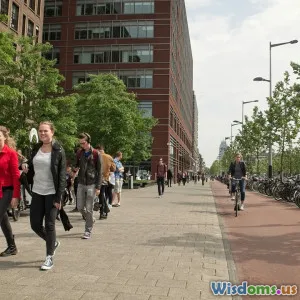
Which Cities Lead in E Scooter Adoption and Why
9 min read Explore the top cities embracing e-scooters, revealing their motivations and infrastructure enabling swift adoption. (0 Reviews)
Which Cities Lead in E-Scooter Adoption and Why
Urban landscapes worldwide are undergoing a rapid transformation, driven largely by the rise of micromobility options — and among these, electric scooters (e-scooters) command particular attention. Once a novelty, e-scooters have become embedded in the daily lives of millions, offering a convenient, eco-friendly, and often cost-effective alternative to traditional transportation methods. But where exactly are e-scooters thriving, and what lessons do these leading cities offer?
Introduction: A Micromobility Revolution Unfolding
E-scooters burst onto the scene around 2017 and quickly captivated urban dwellers seeking quick point-to-point travel without traffic snarls or parking headaches. However, their adoption hasn’t been uniform worldwide. While some cities have become paragons of e-scooter integration, others have struggled with regulation, infrastructure, and cultural acceptance.
In this article, we dive deep into which cities lead the charge in e-scooter adoption and analyze the underlying reasons behind their success. By understanding what drives adoption, planners, policymakers, and entrepreneurs can replicate these trends, fostering smarter, greener urban mobility globally.
The Leaders in E-Scooter Adoption
1. Paris, France: A Model of Progressive Urban Mobility
Paris consistently ranks at the top for e-scooter presence and usage. By 2023, over 20,000 shared e-scooters operated by several companies littered its boulevards.
- Robust Regulation: Paris employed a proactive framework balancing operators' freedom and city control, including caps on fleet size and mandatory parking zones.
- Public Infrastructure Investment: The city invested heavily in protected bike lanes that e-scooter riders also use, improving safety and appeal.
- Environmental Goal Alignment: Paris’s ambitious target to cut greenhouse gas emissions by 60% by 2030 drives strong support for electric mobility options.
According to a survey from IDF Mobilités, e-scooters account for about 10% of short trips under 5km in Paris, reducing car trips significantly.
2. Los Angeles, USA: Tackling Congestion with Micro-Mobility
LA’s notoriously congested sprawl makes it an unlikely but powerful market for e-scooters.
- Pilot Programs and Partnerships: Starting with controlled pilots since 2018, LA expanded e-scooter availability strategically with city agency collaboration.
- Focus on Equity: LA created low-income rider programs, extending access beyond affluent neighborhoods.
- Integration with Public Transit: Many LA Metro stations now feature e-scooter docks, encouraging combined transit use.
The Los Angeles County Metropolitan Transportation Authority (Metro) reported over 15 million e-scooter rides in 2023 alone, highlighting rapid user uptake.
3. Berlin, Germany: Embracing Innovation with Urban Planning
Berlin stands out for its quick integration combined with deliberate urban design adaptations.
- Smart Parking Solutions: Berlin developed dedicated parking zones and smart scooter racks to mitigate clutter.
- Safety Campaigns: Affirmative training and public safety campaigns encourage responsible riding.
- User Diversity: Berlin’s demographic mix, including students and tech enthusiasts, fuels wide-ranging adoption.
A 2022 study by the Berlin Senate noted a 25% increase in e-scooter trips year-over-year, contributing to reduced short car trips.
4. Shanghai, China: Massive Scale and Integration
While known for dockless bike-sharing, Shanghai also leads in e-scooter adoption through scale and technological integration.
- High-Tech Fleet Management: GPS tracking, real-time availability, and AI-powered maintenance tips ensure a smooth user experience.
- Government Support: Shanghai encourages e-scooter use within designated urban zones to ease congestion and pollution.
- Cultural Acceptance: E-scooters offer flexible last-mile connections, matching Shanghai’s dense urban fabric.
In 2023, Shanghai’s municipal data revealed over 40 million e-scooter trips monthly, reflecting its role as an urban mobility hero.
Why Are These Cities Ahead? Key Factors Driving E-Scooter Success
Infrastructure: The Backbone of Adoption
Without dedicated and safe infrastructure, cities risk low usage and public backlash.
- Cities like Paris and Berlin illustrate how protected lanes and organized parking correlate directly with ride frequency.
- According to a 2023 report from the International Transport Forum, cities with over 50km of bike/scooter lanes have up to 3.5x higher micro-mobility adoption.
Regulatory Frameworks: Finding a Balanced Approach
Adoption thrives where regulation protects users and addresses concerns without stifling innovation.
- New York City, which faced e-scooter bans due to safety concerns, contrasts with Paris, which allowed careful sandboxing and operator competition.
- Data-sharing requirements help city planners optimize fleet sizes and placement, reducing clutter and improving safety.
Cultural and Demographic Drivers
Cities with younger populations and tech-forward mindsets, such as Berlin or LA, embrace technological transport quicker.
- Urban dwellers increasingly value convenience, cost savings, and environmental impact, fueling e-scooter popularity.
- Education around safety and etiquette enhances societal acceptance.
Environmental and Mobility Goals
Behind many adoptions is a desire to reduce carbon emissions, alleviate congestion, and improve urban air quality.
- Paris’s aggressive climate commitments act as a catalyst.
- US cities like LA aim to lower solo car trips, integrating e-scooters as part of a comprehensive green transportation strategy.
Integration with Public Transit
Seamless transfers and shared payment systems encourage complementary use rather than competition.
- In Los Angeles, Metro cards and smartphone apps facilitate easy switching between buses, trains, and scooters.
- Shanghai leverages Big Data to coordinate shared fleet management with transit flows.
Real-World Insights From Experts
Dr. Lena Müller, Urban Mobility Specialist:
"Successful e-scooter adoption requires more than just putting scooters on the street. Thoughtful policy, investment in safe cycling infrastructure, and community engagement are crucial to sustainable micromobility ecosystems."
Jacques Dubois, Paris Mobility Coordinator:
"Paris’s approach rests on collaboration—operators, city planners, and riders all have roles. Supporting innovation while maintaining order creates a win-win environment."
Maria Gonzalez, LA City Planner:
"Equity is a key to adoption. We can’t just prioritize affluent areas; everyone benefits from safer, cleaner transportation options."
Conclusion: Pathways Forward for Cities Embracing E-Scooters
The cities leading in e-scooter adoption share common traits: robust infrastructure, smart regulation, cultural embrace, and alignment with larger urban sustainability goals. Their successes demonstrate that e-scooters are not just fad devices but integral pieces of future-forward transport systems.
As urban populations grow and climate challenges intensify, adopting and integrating efficient micro-mobility options like e-scooters will be increasingly important. Policymakers must balance safety, user access, and urban planning innovation to unlock e-scooters’ full benefits.
For residents and city leaders alike, these mobility transformations offer fresh ways to navigate cities — cutting through congestion, lowering emissions, and returning streets to the people. The lessons from Paris, Los Angeles, Berlin, and Shanghai illuminate a roadmap for cities worldwide eager to accelerate their micromobility revolutions.
E-scooters aren’t the future — they’re the exciting urban reality happening right now.
Rate the Post
User Reviews
Other posts in Urban Planning
Popular Posts


















